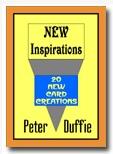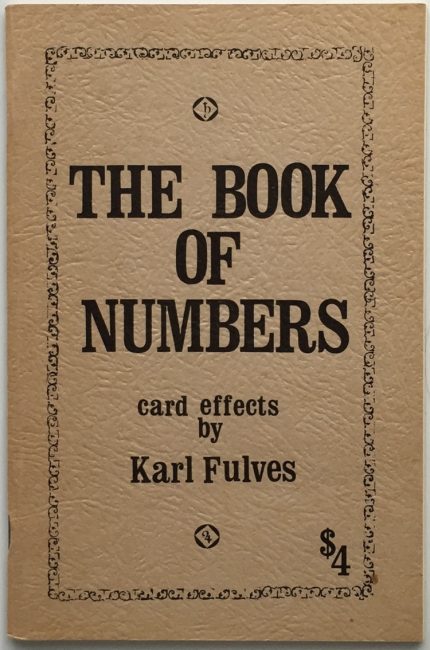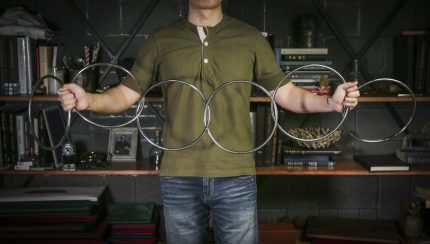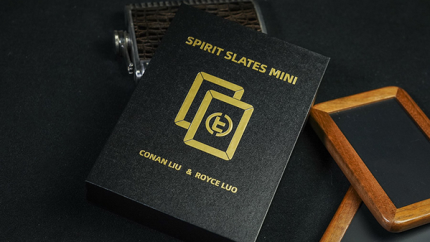BACKLOG: You spread the deck with the faces upwards and invite a spectator to select any card – free choice. This is left face up on the table. You give him the deck and he now spells the name of his card – first the suit, then the value. This produces two random cards. The values of these cards are added – they might be a 3 and a 10 = 13. When the spectator turns his card over it has the number 13 boldly written on the back!
THE DETECTIVE: A spectator selects a card from a packet. Using the name of the famous fictitious sleuth Sherlock Holmes, he successfully locates his card.
MILLENNIUM COUNT DOWN: Another card discovery that is hopefully puzzling!
IN THE NICK OF TIME: Two cards are selected and signed on their faces. Each is sealed inside a separate envelope. One is chosen and burnt. As it burns, you state that the card will leave invisibly and arrive safely inside the other sealed envelope. The other envelope is opened by a spectator and two cards are tipped out. These are both signed cards. However, when the card that was supposedly burnt is turned over its back is seen to be badly charred! Seemingly, the card just escaped in the nick of time!
FOUND BY COINCIDENCE: A two part routine where a spectator successfully finds his own card, then a remarkable coincidence occurs using the other cards.
CLONING: Using the word CLONING, a spectator manages to find two matching cards from a packet he randomly chose.
COLOROSITY: Using positive and negative vibrations, two selected cards travel among cards of opposite colour.
COLOROSITY PLUS!
ROY WALTON ON COLOROSITY: Roy Walton very kindly offered the following variation which get away from the two-hand deal.
COLOUR MAGNET: A spectator is given six cards. He cuts the cards as much as he wants, yet he manages to remove five black cards. The sixth card is a red Queen.
SPRINGHEEL JACK: A spectator removes an Ace, Two, Three Four and Five and mixes them before laying then in a face down row on the table. You remove the Jack of Spades and place it in your pocket. He now selects one of the five cards. This proves to be the Jack of Spades. The missing number card is in your pocket.
HAND PICKED: A spectator deals five hands with five cards in each. He selects any hand, shuffles it, notes a card then gathers all the piles together – these are returned to the deck. You take the deck and produce two cards. The values of which are totalled. they might be a 2 and a 9 = 11. The spectator counts to the 11th card down in the deck to find his selection.
WITHOUT A DARE IN THE WORLD: A spectator freely shuffles a deck then cuts it into two halves on the table. You give him an envelope and he drops it on top of either half. The top card of the other half matches the card inside the envelope!
A STEBBISH LOCATION: While your back is turned, a spectator rolls two dice to get a random number. He deals that number of cards and notes the card at that position. A second spectator, using the same number, deals further into the deck and he too notes a card. Deck is squared then cut by the spectators. Without looking through the cards, you instantly produce the first selection. You then name the other one!
ELVIS HAS LEFT THE BUILDING: You ask a spectator to name king – he might say Diamonds. You cut the KD to the top of the deck and remove the two black Aces. You explain that the King will represent Elvis – the King of Rock ‘n Roll, and the two Aces are his bodyguards. You place Elvis between his bodyguards then pop the sandwich into the card box, which represents the auditorium. You say, “It has only recently come to light that Elvis had a secret way of leaving the auditorium without the fans seeing him. When the announcement was made, ‘Elvis has now left the building,’ he really had.” At this, you toss the deck from hand to hand and instantly produce the three card sandwich – Elvis between his two bodyguards. Finally you say, “And when the fans finally got to his dressing room, they were bitterly disappointed, because all they found was three Elvis impersonators!” The contents of the card box are revealed as the other three Kings!
EASY-GOING DIARY: You give a spectator a diary for inspection – there arerandom playing cards written against every date along with a person’s first name. You then spread a deck of cards face up on the table. They look up their birthday in the diary and announce the name of a playing card written against that date – perhaps the Ace of Spades. You slide the AS out of the spread deck then turn the deck face down. You show the backs as normal. The spectator now announces the name in the diary – perhaps, PHILLIP. When you turn the card face down PHILLIP is boldly written on the back!
JACKS WILL TRAVEL: You remove the four Jacks. A Card is selected and returned to the deck. The deck is cut into two halves – one remains on the table. The four Jacks are placed face up on the table half and cut into the middle. One by one the Jacks leave the tabled half and appear face up in the half in your hands. However, the fourth Jack refuses to travel. But you realise what has happened. You spread the tabled half and the Jack is still there, face up. The card immediately above it proves to be the selection.
LOOKING UPWARDS: The two black Kings are placed on top of the deck. You spread the cards and a spectator chooses any card and leaves it where it it is. You riffle the deck and one of the Kings visibly vanishes, leaving the other one in place on top. The missing King is found right next to the selection. A simple plot but this is done with every card face up throughout! A nice intro, perhaps, to something more elaborate.
MATCHING GILBREATH: A spectator gives the deck a shuffle. You now turn over pairs of cards – every pair consists of a red card and black card. You deposit each pair at a separate place on the table. Magicians yawn as they recognise the Gilbreath Principle. But now you invite them to turn over the pairs and now every pair matches – red-red, black-black and so on!
SPELL-FINDER: A spectator cuts the four Aces into the deck. You now give the deck one straight cut then proceed to spell to all four aces one by one. There are no moves or adjustments during the spelling process.
CIRCULAR TOUR: A prediction with a circle of cards that magically changes to a second prediction.














